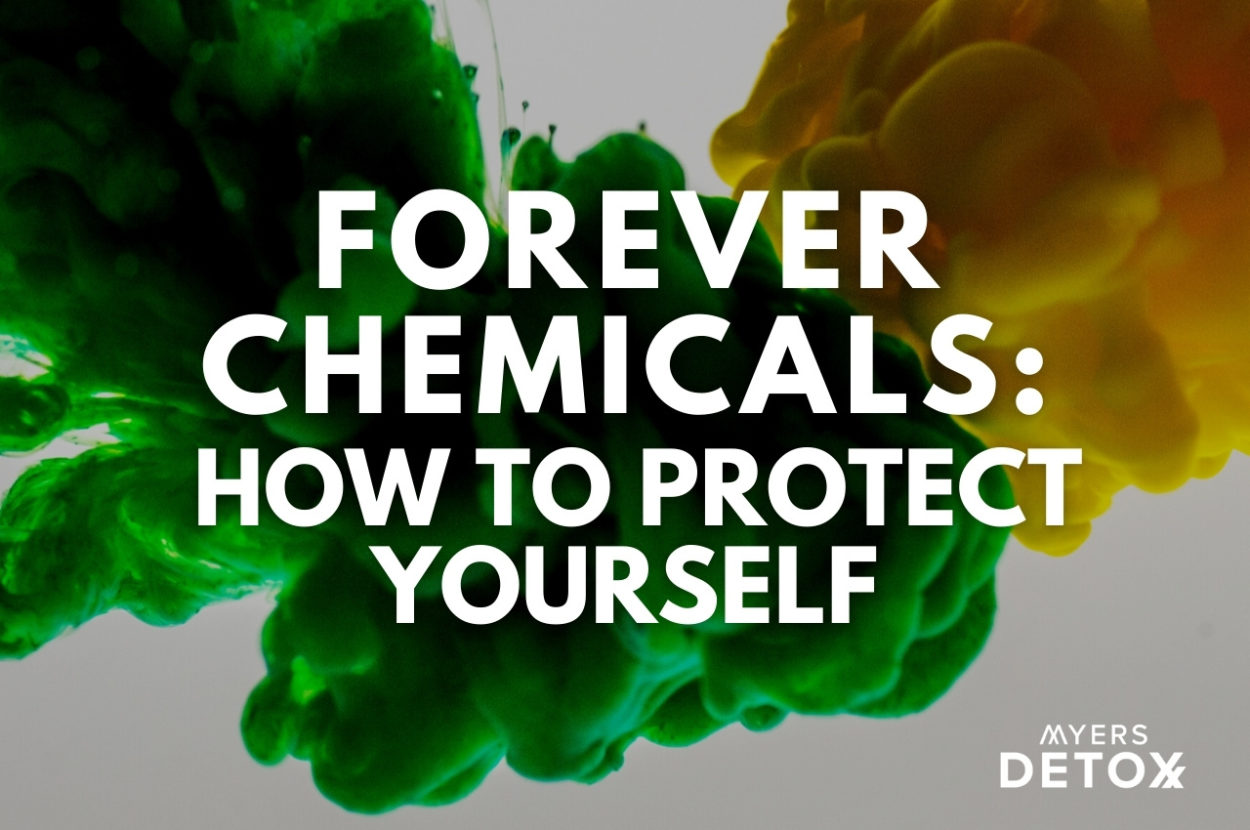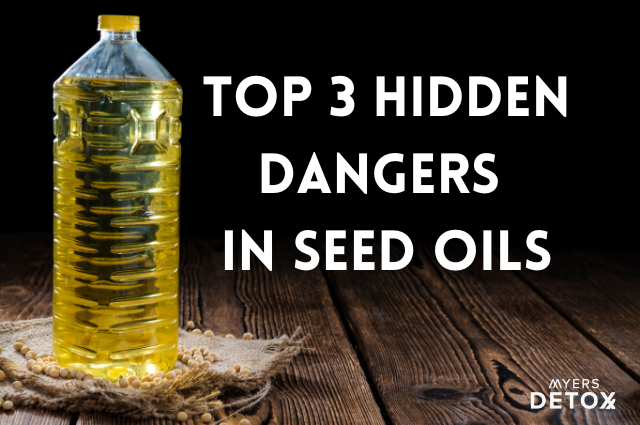The products you use everyday might be a source of harmful toxins known as forever chemicals. In this article you’ll find out what forever chemicals are, where they lurk and how you can protect your health from them.
Back in the 1930s, scientists figured out a way to produce non-stick and waterproof coatings to make consumers’ lives easier. Since then, the use of these chemicals has continued to spread to various industries, preventing food from sticking on your pans, helping water to roll off your raincoat, and providing a stain-free finish to your carpets and furniture.
While these wonder chemicals may sound like a blessing, they come with one significant drawback — they’re toxic to both the environment and your body. These chemical compounds, known as forever chemicals, can now be found ubiquitously in the environment and sneaking their way into the food supply.
In this article, you’ll learn:
- What forever chemicals are
- Where these toxic compounds are hiding in your home
- The serious health threats that forever chemicals carry
- What you can do to mitigate the damaging impact of these chemicals
What Are Forever Chemicals?
Forever chemicals, also known as PFAS (per- and polyfluoroalkyl substances), are human-made chemical compounds that are used in a range of products. As the name implies, these chemicals don’t fully break down, and therefore stick around forever.
What does this mean for the environment?
Over the years, we have seen an accumulation of these compounds, which are slowly contaminating our natural world. The contamination of our water supply is of particular concern, but PFAS have also been found in many different animals on both land and water.
PFAS are used to make fluoropolymer coatings and products that are resistant to heat, oil, stains, grease, and water. As you can imagine, these qualities make them invaluable for a range of products, including non-stick pans, furniture, adhesives, food packaging, and many more.
Some names by which PFAS may go by include PFOS, PFOA, GenX, Teflon, and C-8, but there are more than 5,000 compounds that fall under this category[1].
What Are The Health Risks Of PFAS?
As you can imagine, if PFAS don’t break down and can therefore accumulate in the environment, the same is true for PFAS that make their way into your body. This can result in a range of health risks, as your body doesn’t know what to do with these foreign compounds.
Unfortunately, studies show that most people in the United States have measurable amounts of PFAS in their blood, even if you’re not drinking contaminated water or directly consuming contaminated food. While the biggest concerns are for children and women who are pregnant, no one is really safe from the detrimental impact of these chemicals[2].
Some specific health risks that are associated with PFAS include[3][4][2][5][6]:
- Changes in liver enzymes
- Small decreases in infant birth weights
- Increased risk of high blood pressure or preeclampsia in pregnant women
- Increased cholesterol levels
- Thyroid issues
- Weakened immunity
- Developmental effects in infants
- Infertility risks
- Interference with hormonal systems
- Impaired insulin and blood sugar regulation
Furthermore, animal research shows that PFAS may cause damage to the liver and immune system — which could create a host of other issues. [3]
How You’re Exposed PFAS
PFAS are used ubiquitously in the manufacturing of products that span several different industries. The primary routes of exposure are either the manufacturing process or the use of products containing PFAS.
These toxic compounds can migrate into the soil, water, and air during their production and use. Since most of these compounds don’t break down, they remain in the environment and accumulate. Food grown in soil contaminated with PFAS or with water that’s contaminated can become a secondary source of exposure.
They are also especially mobile in water, which means once they migrate to water from manufacturing plants or through the leaching of products, they can remain intact in our water system for long periods of time[7][8].
In fact, the Environmental Working Group (EWG) estimates that 110 million Americans’ drinking water is contaminated with PFAS[9].
Common sources of PFAS include[10][4]:
- Food packaged in PFOS-containing materials
- Food grown in PFAS contaminated soil or water
- Stain and water-repellent fabrics
- Non-stick (Teflon) products like pots and pans
- Polishes
- Waxes
- Paint
- Cleaning products
- Fire-fighting foams
- Chrome-plating facilities
- Electronics manufacturing facilities
- Drinking water that has been contaminated through landfills, manufacturing plants, or wastewater treatment plants.
- Fish and animals that have accumulated PFAS over time through environmental exposure.
- Hair spray
- Makeup products like eyeliner, foundation, and concealer
- Sunscreen
- Shampoo
- Shaving cream
According to the Environmental Working Group, scientists in California have proposed adding PFOA – a notoriously dangerous PFAS – to Proposition 65’s warning list of chemicals known to cause cancer. [13]
PFOA (Perfluorooctanoic acid, also know as C8) is an industrial chemical commonly used in making Teflon and other non-stick or grease-resistant cookware. It can also be found in fabric or carpets treated stain-resistant sprays, as well as ski wax. [14]
While PFOA was phased out of use in the U.S. in 2005, it can remain in the environment and the human body for a very long time.
Thanks to industrial emissions, PFOA can find its way into drinking water (with levels of PFOA in drinking water being higher in certain areas, like those near chemical plants), some foods, and the air we breathe. [13], [14]
As you can see, many of the products you use daily may contain PFAS. However, even more concerning is the inescapable level of PFAS that are now accumulating in our natural environment.
What You Can Do To Mitigate PFAS Exposure
Although avoiding PFAS altogether may be near impossible, there are certainly ways that you can mitigate, and therefore decrease your exposure to these harmful compounds.
Skip Non-Stick Cookware
Non-stick cookware may add ease to your cleanup process, but most non-stick brands out there use Teflon, a form of PFAS. Over time, the chemicals in the non-stick surface can leach into your food as you cook.
Stainless steel is an excellent alternative. You can also find chemical-free stone cookware. You may need to soak these pans to get the excess food off for a few minutes after cooking, but that task is a small price to pay when it comes to avoiding the buildup of PFAS in your body.
Opt For Natural Personal Care Products
The personal care industry is one of the most dangerous when it comes to PFAS. These products are not only used daily, but they go directly on your skin. Your skin is your largest organ and one that will easily absorb whatever you put on it — chemical compounds included.
PFAS can be found in everything from eyeliner to foundation, to shaving cream, and more.
Luckily, there are several brands that formulate to keep dangerous compounds out of their personal care products. If you’re not sure which brand to go with, you can use the Environmental Working Group Skin Deep database. Here you can search by ingredient, product, or brand to find the right products for you.
Avoid Stain-Repellent Treatments
If you have little kids or pets, you may be tempted to get stain-repellent treatments on your furniture and carpets. These treatments not only bring more PFAS into your home, but they could leach into the air you breathe.
Much like the case with non-stick cookware, the convenience of stain-repellent treatments is not worth the risks of PFAS.
Be Wary Of Water-Repellent Clothing
Many outdoor sporting goods and clothing lines use water-repellent coatings. Bathing suites, jackets, boots, etc. may all be sprayed with PFAS to keep the water off. Some people even spray water-repellents on all their suede and leather shoes to avoid water stains.
If you see the words “water repellent” on any product you are about to buy, that should be a big red flag that PFAS are present.
Use Water Filters
As the EWG stated, it’s estimated that 110 million Americans are drinking water that is contaminated with PFAS. This means that even if you’re doing your best to avoid obvious sources of PFAS, they could still be sneaking in through your water supply.
No matter where you live, you should always be using a water filter.
The best filters for PFAS are reverse osmosis filters. You can have these filters installed right into your home, or you can use external filters (which are a bit less expensive) and run your water through the filters before you use it.
PFAS will not degrade by boiling water, so please be sure to always filter your water before using it for tea, coffee, or any type of cooking.
Eat At Home
Eating out is another way that PFAS can sneak into your diet. Restaurants tend to use lower quality cookware that likely contains Teflon or other types of non-stick PFAS. What’s more, the to-go packaging at fast food restaurants is a known source of PFAS.
Higher-end restaurants are more likely to stainless steel as opposed to Teflon cookware, but it could become pretty expensive to only eat out at high end establishments.
Cooking from home is one of the best ways to truly stay on top of your food quality. When you dine out, you rarely know if the food you’re eating is organic, grass-fed, free-range, or fresh.
Not to say that you should never treat yourself to a meal out, but do so mindfully and try to cook most of your food at home whenever possible.
Support Detoxification
Unfortunately, even if you follow all of the above guidelines, you’ll likely still have some level of PFAS in your body. As research shows, most American’s have a measurable amount of PFAS in their blood[2].
If these chemical compounds are somewhat unavoidable, the only way to truly mitigate the damage is to support your body’s detoxification systems.
The world we live in is full of toxic insults, pollution, heavy metals, forever chemicals, and the list goes on. Caring for your liver and your detox pathways is really no longer a luxury; it’s become a crucial part of maintaining your wellbeing.
Optimizing liver function is crucial to detox the body of the thousands of chemicals we come into contact with daily. And to aid the over 500 functions the liver does in the body.
This is exactly why I created my 14-Day Liver Rehab Cleanse. Supporting detoxification is a passion of mine, and I’ve seen how much it’s impacted both my health and the health of my clients.
Through years of research, I’ve figured out the best techniques to keep your liver running at full capacity, and this 14-Day Liver Rehab Cleanse is the summation of everything I’ve learned, packaged in a way that’s digestible and simple to implement.
During the cleanse, you’ll get:
- Information about which foods to focus on to boost your liver detox pathways, and which to avoid.
- The best herbs and supplement to use for detox.
- Liver cleansing “how-to” videos
- 3-Part liver rehab webinar
- And much more.
The Takeaway
While measures are being taken to reduce the production of forever chemicals, the fact remains that they have been around for a while and because they can’t degrade; they will be lingering in our environment long after us.
You can mitigate your exposure to become aware of the products that contain PFAS and reduce your usage. A simple way to look at it is to be wary of anything that’s marketing as non-stick, water-repellent, stain-proof, etc.
If it seems too good to be true, it might be forever chemicals.
Meanwhile, caring for your body’s natural detoxification processes will assist in the removal of these compounds from your body. The danger with PFAS is that they can build up over time, so if you are continually helping your body flush the excess, you will be doing wonders for yourself.










